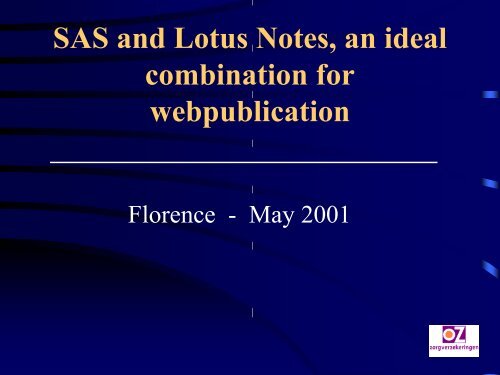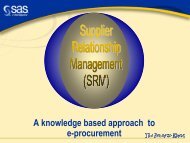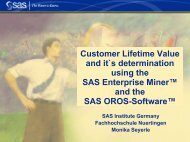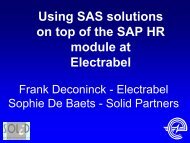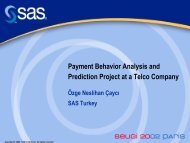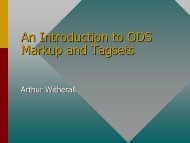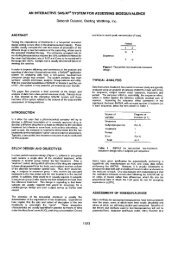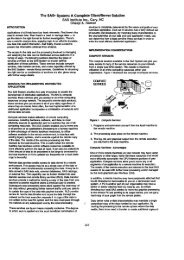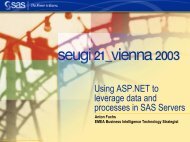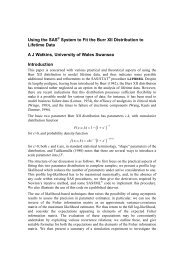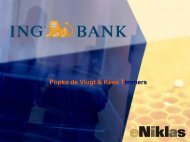SAS and Lotus Notes, an ideal combination for ... - sasCommunity
SAS and Lotus Notes, an ideal combination for ... - sasCommunity
SAS and Lotus Notes, an ideal combination for ... - sasCommunity
Create successful ePaper yourself
Turn your PDF publications into a flip-book with our unique Google optimized e-Paper software.
<strong>SAS</strong> <strong><strong>an</strong>d</strong> <strong>Lotus</strong> <strong>Notes</strong>, <strong>an</strong> <strong>ideal</strong><br />
<strong>combination</strong> <strong>for</strong><br />
webpublication<br />
Florence - May 2001
Agenda<br />
Presentation <strong>SAS</strong> <strong><strong>an</strong>d</strong> <strong>Lotus</strong> <strong>Notes</strong><br />
Introduction<br />
Tables on the intr<strong>an</strong>et<br />
Charts<br />
A clickable map<br />
Conclusion
Introduction<br />
OZ zorgverzekeringen<br />
Health insur<strong>an</strong>ce as core-bussiness<br />
615.000 insurees, 590.000 ZFW<br />
Main office in Breda, a few offices around the area<br />
550 employees<br />
travel-insur<strong>an</strong>ce (Europeese) <strong><strong>an</strong>d</strong> other insur<strong>an</strong>ce<br />
prodcuts (ASR, Axent/ Aegon)
Tables on the intr<strong>an</strong>et (1)<br />
Static or dynamic?<br />
Why on the intr<strong>an</strong>et?<br />
ODS HTML output destination<br />
NOTESDB access engine
Tables on the intr<strong>an</strong>et (2)<br />
a simple static webpage<br />
filename odsout "d:\hugs\output";<br />
ods html body = "polissenikazp.html"<br />
path = odsout<br />
newfile = output;<br />
title ”A<strong>an</strong>tal IKAZ-P polissen";<br />
proc tabulate data=d1 missing;<br />
run;<br />
ods html close;
filename sasintra notesdb;<br />
Tables on the intr<strong>an</strong>et (3)<br />
adding a page to <strong>an</strong> existing LN-database<br />
data _null_;<br />
FILE sasintra;<br />
PUT '!NSF_DB! d:\testserver\notes\data\hugs\sasintra.nsf';<br />
PUT "!NSF_ATTACH! d:\hugs\output\ikazp.html";<br />
PUT '!NSF_FORM! RAPH00';<br />
PUT "!NSF_FIELD!Titel!A<strong>an</strong>tal polissen Ikaz-P";<br />
PUT '!NSF_FIELD!Status!Publiceren';<br />
PUT '!NSF_FIELD!SoortRapport!1';<br />
PUT '!NSF_FIELD!RapportType!Per rechtsgrond';<br />
PUT "!NSF_FIELD!Jaar!2000";<br />
PUT "!NSF_FIELD!Ma<strong><strong>an</strong>d</strong>!Oktober";<br />
PUT "!NSF_FIELD!Periode!10";<br />
PUT '!NSF_FIELD!Soortverzekering!Hoofdverzekering';<br />
PUT "!NSF_FIELD!DocCode!ikazp";<br />
PUT "!NSF_FIELD!RapportUrl!/hugs/sasintra.nsf/DbCode/ikazp/$file/ikazp.html?OpenElement";<br />
run;
Tables on the intr<strong>an</strong>et (4)<br />
extra features<br />
Tables with drilldown-facilities<br />
Tables in Excel<br />
Creating tables with a different (comp<strong>an</strong>y) ‘style’
Tables on the intr<strong>an</strong>et (5)<br />
a static webpage with drilldown<br />
proc <strong>for</strong>mat;<br />
value $ozc<br />
'00' ='Buitenl<strong><strong>an</strong>d</strong>'<br />
'11' ='Brab<strong>an</strong>t’;<br />
run;<br />
filename odsout "d:\hugs\output";<br />
ods html body = "rg.html" path = odsout newfile = output;<br />
proc tabulate data=hugs.hugsd1_2;<br />
<strong>for</strong>mat ozc $ozcc.;<br />
run;<br />
ods html close;
Tables on the intr<strong>an</strong>et (6)<br />
a static webpage with a link to Excel<br />
filename odsout "d:\hugs\output";<br />
ods html body = "polissenikazpexcel.html"<br />
path = odsout<br />
newfile = output;<br />
title "A<strong>an</strong>tal IKAZ-P polissen";<br />
title2 " %bquote() ";<br />
proc tabulate data=d1 out=d1_2 (drop=_page_ _type_ _table_);<br />
run;<br />
ods html close;
Tables on the intr<strong>an</strong>et (7)<br />
creating a new style<br />
proc template;<br />
define style intra1;<br />
PARENT=styles.default;<br />
STYLE Body FROM Body/<br />
BACKGROUNDIMAGE='logo_zt.gif’; /* Background */<br />
STYLE SystemTitle FROM SystemTitle / /* Title above table */<br />
FONT_SIZE = 4<br />
FOREGROUND = or<strong>an</strong>ge<br />
BACKGROUND = purple;<br />
STYLE Header FROM Header / /* Column-head */<br />
FONT_SIZE = 2<br />
FOREGROUND = or<strong>an</strong>ge<br />
BACKGROUND = purple;<br />
STYLE Data FROM Data / /* Cellse */<br />
FONT_SIZE = 2<br />
FOREGROUND = white<br />
BACKGROUND = purple;<br />
end;<br />
run;;
Tables on the intr<strong>an</strong>et (8)<br />
using a different style<br />
filename odsout "d:\hugs\output";<br />
ods html body = "polissenikazpstyle.html"<br />
path = odsout<br />
newfile = output<br />
style = intra1;<br />
title "A<strong>an</strong>tal IKAZ-P polissen";<br />
proc tabulate data=d1 missing;<br />
run;<br />
ods html close;
Different devices<br />
Static or dynamic?<br />
Charts (1)<br />
Extra options using frames
Charts (2)<br />
a webpage with a GIF-chart<br />
proc catalog cat=work.gseg kill;<br />
quit;<br />
filename odsout "d:\hugs\output\maag\hagro04";<br />
ods html body="graf.html"<br />
path=odsout<br />
base="/hugs/sasintra.nsf/DbCode/04gif/$file/";<br />
goptions device=gif;<br />
title "A<strong>an</strong>tal DDD's Maagmiddelen";<br />
proc gchart data = hugs.grafdata;<br />
quit;<br />
ods html close;
Charts (3)<br />
some nice features using the JAVA-device<br />
filename odsout "d:\hugs\output\maag\hagro04";<br />
ods html file="graf.html"<br />
path=odsout<br />
base="/hugs/sasintra.nsf/dbcode04java/$file/"<br />
archive="/hugs/sasintra.nsf/dbluid/ba99e/$file/graphapp.jar";<br />
goptions device=java;<br />
title "A<strong>an</strong>tal DDD's Maagmiddelen";<br />
proc gchart data = hugs.grafdata;<br />
quit;<br />
ods html close;
Charts (4)<br />
a frame with a table of contents<br />
filename odsout "d:\hugs\output\maag\hagro04";<br />
ods html frame='frame.html'<br />
contents='contents.html'<br />
body="body.html"<br />
path=odsout<br />
base="/hugs/sasintra.nsf/dbcode04gifetc/$file/";<br />
title "A<strong>an</strong>tal DDD's Maagmiddelen";<br />
proc tabulate data = hugs.grafdata;<br />
run;<br />
goptions device=gif;<br />
proc gchart data = hugs.grafdata;<br />
quit;<br />
ods html close;
Charts (4)<br />
JAVA-metaframe<br />
goptions device=javameta;<br />
filename _webout "d:\hugs\output\maag\hagro04\mchart.htm";<br />
proc gchart data = hugs.grafdata;<br />
quit;<br />
filename _webout "d:\hugs\output\maag\hagro04\mchart2.htm";<br />
proc gchart data = hugs.grafdata;<br />
quit;<br />
filename _webout "d:\hugs\output\maag\hagro04\mchart3.htm";<br />
proc gchart data = hugs.grafdata;<br />
quit;<br />
filename _webout;
Charts (5)<br />
JAVA-metaframe<br />
filename htmlout "d:\hugs\output\maag\hagro04\mchartmain.htm";<br />
data _null_ ;<br />
file htmlout ;<br />
put '';<br />
put '';<br />
put ' Working with Multiple Metacode Files ';<br />
put '';<br />
put '';<br />
put ' ';<br />
put '';<br />
put ' ';<br />
put ' ';<br />
put ' ';<br />
put ' ';<br />
put ' ';<br />
put ' ';<br />
put ' ';<br />
put ' ';<br />
put ' ';<br />
put ' ';<br />
put ' ';<br />
put ' ';<br />
put ' ';<br />
put ' ';<br />
put 'Sorry, your browser does not support the applet tag.';<br />
put '';<br />
put '';<br />
put '';<br />
run;
A clickable map<br />
data hagros;<br />
retain XSys YSys '2' When 'A' Position 'E';<br />
length text $2;<br />
x=28.8; y=29.2; text='g'; HTML = 'href="/hugs/sasintra.nsf/DbCode/m040/$file/mchartmain.htm?OpenElement"';<br />
output;<br />
x=29; y=28.3; text='04'; HTML='';<br />
output;<br />
x=29.4; y=29.2; text='r'; HTML = 'href="/hugs/<strong>SAS</strong>Intra.NSF/<strong>SAS</strong>report?OpenAgent&04"';<br />
output;<br />
keep XSys YSys When Position Text X Y HTML;<br />
run;<br />
ods html file='eggkaart.htm'<br />
path=odsout<br />
base="/hugs/sasintra.nsf/DbCode/egg01/$file/";<br />
proc gmap data=hulp map=hugs.ozkaart;<br />
id k_egg;<br />
choro eggnr /discrete nolegend <strong>an</strong>no=hagros coutline=black;<br />
title font=hwdmx065 h=7 c=black 'Economische Geografisch Gebieden';<br />
run;<br />
quit;<br />
ods html close;
Conclusion<br />
adv<strong>an</strong>tages using <strong>SAS</strong> (ODS)<br />
It’s easy to create webpages<br />
It’s possible to make nice webpages by creating a<br />
(comp<strong>an</strong>y) style<br />
Lots of nice features using different devices
Conclusion<br />
adv<strong>an</strong>tages using <strong>Lotus</strong> <strong>Notes</strong><br />
All webpages are within one (or a few) LNdatabases<br />
LN provides easy navigation<br />
It’s easy to use LN-security<br />
You c<strong>an</strong> use the existing infrastructure
<strong>SAS</strong> ® <strong><strong>an</strong>d</strong> <strong>Lotus</strong> <strong>Notes</strong> ® <strong>an</strong> <strong>ideal</strong> <strong>combination</strong> <strong>for</strong> webpublication<br />
Erwin v<strong>an</strong> Dongen<br />
OZ Health Insur<strong>an</strong>ce<br />
Breda, The Netherl<strong><strong>an</strong>d</strong>s<br />
Abstract<br />
With the help of the Output Delivery System (ODS) it has become very easy to<br />
generate HTML Output. St<strong><strong>an</strong>d</strong>ard reports, which were previously distributed on<br />
paper, c<strong>an</strong> now be published on <strong>an</strong> Intr<strong>an</strong>et through (static) HTML-pages. To<br />
administrate large qu<strong>an</strong>tities of HTML pages, they are stored in one or more<br />
<strong>Lotus</strong> <strong>Notes</strong> databases. Then they c<strong>an</strong> act as <strong>an</strong> Intr<strong>an</strong>et with the help of a<br />
<strong>Lotus</strong> Domino server.<br />
In this presentation it is shown how easy it is to generate HTML-pages in a<br />
nice lay-out. Particular attention will be paid to tables (proc tabulate),<br />
graphics (proc gchart) <strong><strong>an</strong>d</strong> maps (proc gmap).<br />
Of course the storage of all the output in a <strong>Lotus</strong> <strong>Notes</strong> (LN) database with the<br />
help of the NOTESDB access engine will be a major part of the presentation.<br />
A demonstration will highlight the adv<strong>an</strong>tages of this method.<br />
1. Tables on the intr<strong>an</strong>et<br />
The easiest way to publish in<strong>for</strong>mation on the intr<strong>an</strong>et is to create a static webpage. When you<br />
have a piece of existing code in which you create a table using the tabulate procedure it is<br />
pretty easy to capture the output of the procedure in a HTML-file. All you have to do is to add<br />
a few ODS-statements to your code as is shown in the example.<br />
Example: A simple static webpage<br />
filename odsout "d:\hugs\output";<br />
ods html body = "polissenikazp.html"<br />
path = odsout<br />
newfile = output;<br />
title ”A<strong>an</strong>tal IKAZ-P polissen";<br />
proc tabulate data=d1 missing;<br />
run;<br />
ods html close;<br />
If the destination (represented by the filename reference) is somewhere on your webserver<br />
then the output is immediately available on the intr<strong>an</strong>et. However this paper is about<br />
publishing it on a Domino-webserver in which case you have to put your output in a LNdatabase.<br />
The following comm<strong><strong>an</strong>d</strong>s c<strong>an</strong> be used to create a new <strong>Notes</strong> document <strong><strong>an</strong>d</strong> to store<br />
it in a <strong>Notes</strong> database.<br />
1
Example: Adding a <strong>Notes</strong> document to <strong>an</strong> existing LN-database<br />
filename sasintra notesdb;<br />
data _null_;<br />
FILE sasintra;<br />
PUT '!NSF_DB! d:\testserver\notes\data\hugs\sasintra.nsf'; /* Name of the LN-database */<br />
PUT "!NSF_ATTACH! d:\hugs\output\ikazp.html"; /* Name of the HTML-file */<br />
PUT '!NSF_FORM! RAPH00'; /* Name of the <strong>for</strong>m to use */<br />
PUT "!NSF_FIELD!Titel!A<strong>an</strong>tal polissen Ikaz-P"; /* Field defined in the <strong>for</strong>m */<br />
PUT '!NSF_FIELD!Status!Publiceren'; /* Field defined in the <strong>for</strong>m */<br />
PUT '!NSF_FIELD!SoortRapport!1'; /* Field defined in the <strong>for</strong>m */<br />
PUT '!NSF_FIELD!RapportType!Per rechtsgrond'; /* Field defined in the <strong>for</strong>m */<br />
PUT "!NSF_FIELD!Jaar!2000"; /* Field defined in the <strong>for</strong>m */<br />
PUT "!NSF_FIELD!Ma<strong><strong>an</strong>d</strong>!Oktober"; /* Field defined in the <strong>for</strong>m */<br />
PUT "!NSF_FIELD!Periode!10"; /* Field defined in the <strong>for</strong>m */<br />
PUT '!NSF_FIELD!Soortverzekering!Hoofdverzekering'; /* Field defined in the <strong>for</strong>m */<br />
PUT "!NSF_FIELD!DocCode!ikazp"; /* Unique reference to the new LN-document */<br />
PUT "!NSF_FIELD!RapportUrl!/hugs/sasintra.nsf/DbCode/ikazp/$file/ikazp.html?OpenElement";<br />
/* URL containing DocCode <strong><strong>an</strong>d</strong> name of HTML */<br />
run;<br />
First a file name reference is created which specifies that the <strong>Notes</strong>DB access engine is to be<br />
used. Then, the data is written to this file. The <strong>Notes</strong> database that is to be opened is specified.<br />
Then the HTML file that is to be attached is indicated. In this example, we use a<br />
predetermined <strong>Notes</strong> <strong>for</strong>m (RAPH00). Finally, the fields that belong to this <strong>for</strong>m are filled in.<br />
It is import<strong>an</strong>t to note that the DocCode must be unique <strong><strong>an</strong>d</strong> must be specified in the<br />
RapportUrl.<br />
Requirements<br />
To use the <strong>Notes</strong>DB access engine it is necessary to specify the directory in which the<br />
notes.ini <strong><strong>an</strong>d</strong> the notes.exe are found in your search path. This c<strong>an</strong> be done in the control<br />
p<strong>an</strong>el system. Go to environment <strong><strong>an</strong>d</strong> ch<strong>an</strong>ge the variable ‘path’. Add the extra directories to<br />
the path. For example (<strong>for</strong> Windows NT) c:\notes\data;c:\notes’. See <strong>for</strong> more in<strong>for</strong>mation<br />
Walker, 1997.<br />
A table gets much more interesting when you add some extra features to it. The following<br />
examples show how you c<strong>an</strong> add a drilldown to your table, how you c<strong>an</strong> make a link to <strong>an</strong><br />
Excel-spreadsheet (so a user c<strong>an</strong> download the in<strong>for</strong>mation) <strong><strong>an</strong>d</strong> how you c<strong>an</strong> create <strong><strong>an</strong>d</strong> add a<br />
(comp<strong>an</strong>y) style.<br />
Example: A static webpage with drilldown<br />
proc <strong>for</strong>mat;<br />
value $ozc<br />
'00' ='Buitenl<strong><strong>an</strong>d</strong>'<br />
'11' ='Brab<strong>an</strong>t’;<br />
run;<br />
filename odsout "d:\hugs\output";<br />
ods html body = "rg.html"<br />
path = odsout<br />
newfile = output;<br />
proc tabulate data=hugs.hugsd1_2;<br />
run;<br />
ods html close;<br />
2
filename odsout "d:\hugs\output";<br />
ods html body = "regio.html"<br />
path = odsout<br />
newfile = output;<br />
proc tabulate data=hugs.hugsd1_2;<br />
<strong>for</strong>mat ozc $ozc.;<br />
run;<br />
ods html close;<br />
In this example the $ozc-<strong>for</strong>mat contains links to other HTML-files. In the first proc tabulate<br />
a HTML-file is created <strong>for</strong> each ozc. These files are automatically numbered rg.html, rg1.html<br />
<strong><strong>an</strong>d</strong> so on. The second proc tabulate creates one HTML-file (regio.html) containing a table in<br />
which the ozc-variable is a row-variable which is <strong>for</strong>matted with the links to the other created<br />
HTML-files. Finally you add all files to your LN-database <strong><strong>an</strong>d</strong> you make sure that only<br />
regio.html c<strong>an</strong> be addressed directly.<br />
To give a user more possibilities to use the data represented by a HTML-table you c<strong>an</strong> store<br />
the data in <strong>an</strong> Excel-file <strong><strong>an</strong>d</strong> link the file to the HTML-document. This is shown below.<br />
Example: A static webpage with a link to Excel<br />
filename odsout "d:\hugs\output";<br />
ods html body = "polissenikazpexcel.html"<br />
path = odsout<br />
newfile = output;<br />
title "A<strong>an</strong>tal IKAZ-P polissen";<br />
title2 " %bquote() ";<br />
proc tabulate data=d1 out=d1_2 (drop=_page_ _type_ _table_);<br />
run;<br />
ods html close;<br />
Here a link to Excel is added in the title2-statement. The Href points to a pre-created Excelfile<br />
(which c<strong>an</strong> be located in the LN-database) <strong><strong>an</strong>d</strong> the Excel-logo is used as the link. Users<br />
who like to create their own graphs or tables using Excel c<strong>an</strong> now download the in<strong>for</strong>mation<br />
<strong><strong>an</strong>d</strong> c<strong>an</strong> do whatever they like with it.<br />
ODS gives you the possibility to control the look <strong><strong>an</strong>d</strong> feel of the HTML-files you create. One<br />
of the tools to do so is to create a style using the template-procedure. This paper doesn’t cover<br />
all the options, but a small example is shown below.<br />
Example: Creating a new style<br />
proc template;<br />
define style intra1;<br />
PARENT=styles.default;<br />
STYLE Body FROM Body/<br />
BACKGROUNDIMAGE='logo_zt.gif’; /* Background */<br />
STYLE SystemTitle FROM SystemTitle / /* Title above table */<br />
FONT_SIZE = 4<br />
FOREGROUND = or<strong>an</strong>ge<br />
BACKGROUND = purple;<br />
STYLE Header FROM Header / /* Column-head */<br />
FONT_SIZE = 2<br />
FOREGROUND = or<strong>an</strong>ge<br />
BACKGROUND = purple;<br />
STYLE Data FROM Data / /* Cells */<br />
FONT_SIZE = 2<br />
FOREGROUND = white<br />
BACKGROUND = purple;<br />
end;<br />
run;<br />
3
In this style the default style is used as the base. Instead of the grey background a logo is used.<br />
Furthermore the fontsize, <strong>for</strong>eground <strong><strong>an</strong>d</strong> background of the title, column-heads <strong><strong>an</strong>d</strong> cells are<br />
ch<strong>an</strong>ged. The following example shows how this new style c<strong>an</strong> be used.<br />
Example: using a different style<br />
filename odsout "d:\hugs\output";<br />
ods html body = "polissenikazpstyle.html"<br />
path = odsout<br />
newfile = output<br />
style = intra1;<br />
title "A<strong>an</strong>tal IKAZ-P polissen";<br />
proc tabulate data=d1 missing;<br />
run;<br />
ods html close;<br />
To use a different style, simply add the style-option to the ODS-statement.<br />
2. Graphs<br />
Creating graphs to publish on the intr<strong>an</strong>et is somewhat more complicated because on the one<br />
h<strong><strong>an</strong>d</strong> you have to create the image (<strong>for</strong> example a GIF) <strong><strong>an</strong>d</strong> on the other h<strong><strong>an</strong>d</strong> you have to<br />
create a HTML-file in which the GIF is embedded. Luckily ODS does the necessary work <strong>for</strong><br />
you. The following example creates a graph using proc gchart with the GIF-device.<br />
Example: a webpage with a GIF-graph<br />
proc catalog cat=work.gseg kill;<br />
quit;<br />
filename odsout "d:\hugs\output\maag\hagro04";<br />
ods html body="graf.html"<br />
path=odsout<br />
base="/hugs/sasintra.nsf/DbCode/04gif/$file/";<br />
goptions device=gif;<br />
title "A<strong>an</strong>tal DDD's Maagmiddelen";<br />
proc gchart data = hugs.grafdata;<br />
quit;<br />
ods html close;<br />
The proc catalog in the example above makes sure that the gseg-catalog is empty when the<br />
new graph is created. The GIF-file is automatically named gchartx.gif where x is the number<br />
of the graph in the catalog. When you w<strong>an</strong>t to add the GIF to a LN-database the name must be<br />
known. By emptying the catalog you c<strong>an</strong> be sure that in this case the GIF-file is named<br />
gchart.gif. The ODS-statement looks almost the same as the ODS-statement that is used in the<br />
previous (table) examples. The only new part is the base-option. This option makes sure that<br />
the HTML-file that’s been created contains the correct link to the GIF. It is the URL to the<br />
GIF.<br />
Both the HTML-file <strong><strong>an</strong>d</strong> the GIF-file c<strong>an</strong> be added to the LN-database. The GIF file will be<br />
stored such that it c<strong>an</strong> not be asked <strong>for</strong> directly. Only through the HTML-file the GIF will be<br />
shown.<br />
It is also possible to use different devices. The Java-device <strong>for</strong> example gives the user a lot<br />
more possibilities to interact. The example below shows the use of the JAVA-device.<br />
4
Example: a webpage with a JAVA-graph<br />
filename odsout "d:\hugs\output\maag\hagro04";<br />
ods html file="graf.html"<br />
path=odsout<br />
base="/hugs/sasintra.nsf/dbcode04java/$file/"<br />
archive="/hugs/sasintra.nsf/dbluid/ba99e/$file/graphapp.jar";<br />
goptions device=java;<br />
title "A<strong>an</strong>tal DDD's Maagmiddelen";<br />
proc gchart data = hugs.grafdata;<br />
quit;<br />
ods html close;<br />
The only difference is the device=java <strong><strong>an</strong>d</strong> the archive-option that is added to the ODSstatement.<br />
The last one contains the URL to the JAVA-applet that has to be used while<br />
viewing the graph. In our case this applet is also attached to a <strong>Notes</strong>-document in the LNdatabase.<br />
So far we’ve been creating either a graph or a table. When you create both (or more) it c<strong>an</strong> be<br />
very nice to create a table of contents as well. In the next example a frame is created in which<br />
the left side contains a table of contents <strong><strong>an</strong>d</strong> the right side contains a graph <strong><strong>an</strong>d</strong> a table.<br />
Example: a frame with a table of contents<br />
filename odsout "d:\hugs\output\maag\hagro04";<br />
ods html frame='frame.html'<br />
contents='contents.html'<br />
body="body.html"<br />
path=odsout<br />
base="/hugs/sasintra.nsf/dbcode04gifetc/$file/";<br />
title "A<strong>an</strong>tal DDD's Maagmiddelen";<br />
proc tabulate data = hugs.grafdata;<br />
run;<br />
goptions device=gif;<br />
proc gchart data = hugs.grafdata;<br />
quit;<br />
ods html close;<br />
In the ODS-statement the file-option has been replaced by the frame, contents <strong><strong>an</strong>d</strong> bodyoption.<br />
The base now is the path to the contents, body <strong><strong>an</strong>d</strong> GIF. By attaching these three files<br />
in one <strong>Notes</strong>-document (which itself is not published) the link between the frame (which is<br />
published) <strong><strong>an</strong>d</strong> the rest is established.<br />
5
3. A clickable map<br />
The last part of this paper shows <strong>an</strong> example of a clickable map. A map is created using the<br />
GMAP-procedure <strong><strong>an</strong>d</strong> hotspots are added using the <strong>an</strong>notate-facility.<br />
Example: a clickable map<br />
data hagros;<br />
retain XSys YSys '2' When 'A' Position 'E';<br />
length text $2;<br />
x=28.8; y=29.2; text='g'; HTML =<br />
'href="/hugs/sasintra.nsf/DbCode/m040/$file/mchartmain.htm?OpenElement"';<br />
output;<br />
x=29; y=28.3; text='04'; HTML='';<br />
output;<br />
x=29.4; y=29.2; text='r'; HTML = 'href="/hugs/<strong>SAS</strong>Intra.NSF/<strong>SAS</strong>report?OpenAgent&04"';<br />
output;<br />
keep XSys YSys When Position Text X Y HTML;<br />
run;<br />
ods html file='eggkaart.htm'<br />
path=odsout<br />
base="/hugs/sasintra.nsf/DbCode/egg01/$file/";<br />
proc gmap data=hulp map=hugs.ozkaart;<br />
id k_egg;<br />
choro eggnr /discrete nolegend <strong>an</strong>no=hagros coutline=black;<br />
title font=hwdmx065 h=7 c=black 'Economische Geografisch Gebieden';<br />
run;<br />
quit;<br />
ods html close;<br />
In the datastep <strong>an</strong> <strong>an</strong>notate dataset is created. This dataset contains x <strong><strong>an</strong>d</strong> y co-ordinates of<br />
hotspots. The variable text is the hotspot that is shown on the map <strong><strong>an</strong>d</strong> the HTML-variable<br />
contains the URL to go to when the user clicks on the hotspot. In this case the first hotspot<br />
(‘g’) goes to <strong>an</strong>other HTML-file in the LN-database. The other hotspot (‘r’) starts a LN-agent<br />
with 04 as a parameter.<br />
The GMAP-procedure creates the map <strong><strong>an</strong>d</strong> uses the <strong>an</strong>notate-dataset to create the hotspots.<br />
Conclusion<br />
The new Output Delivery System makes it very easy to create HTML-output. Both text<br />
(tables) <strong><strong>an</strong>d</strong> graphics c<strong>an</strong> be made by adding a few statements to your existing code. By<br />
adding some HTML-statements yourself or by using different options <strong><strong>an</strong>d</strong> devices you c<strong>an</strong><br />
add extra features <strong>for</strong> extra functionality or just to make it all look a bit nicer. By using <strong>Lotus</strong><br />
<strong>Notes</strong> to store all webcontent everything is stored in a structured way. Besides that it is<br />
possible to use <strong>an</strong> existing infrastructure including security <strong><strong>an</strong>d</strong> navigation.<br />
References<br />
Walker, Jamie (1997) Integrating <strong>Lotus</strong> <strong>Notes</strong> ® with <strong>SAS</strong> ® , <strong>SAS</strong> ®<br />
6


